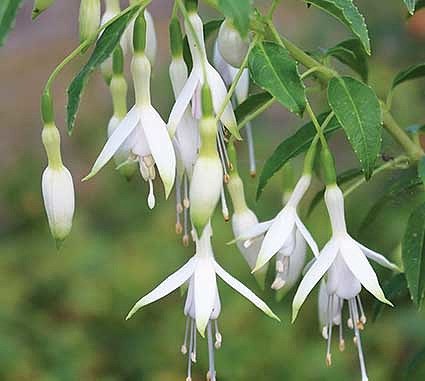
Gardening Journal: Plant of the month – Fuchsia Hawkshead
September is the start of the summer crescendo with autumn flowering perennials in full bloom and the ornamental grasses in their prime. Vibrant colours and low autumnal light combine in dramatic effect, creating silhouettes and shadows that are not seen any other time of the year. It’s a time to wind down and rest with time to enjoy the fruits of your labour from the previous year. Soon it will be time to start it all over again, preparing for the winter tidy up and next years blooms.Fuchsias often remind us of old-fashioned bedding schemes and tired hanging baskets, completely out of fashion and favour on the horticultural show circuit. Yes, they’ve lurked around, largely overlooked, in cottage gardens since Victorian times, but it doesn’t mean they are not worth a second look and we shouldn’t take them for granted either.
Fuchsia is a genus of flowering plants that consists mostly of shrubs or small trees. There are over 110 recognised species. The first, Fuchsia triphylla, was discovered in the Caribbean in about 1696 by the French monk and botanist, Charles Plumier. He named the new genus after the renowned German botanist Leonhart Fuchs.
Fuchsias are versatile plants, although not native, they have naturalised in many parts of this world, including some parts of Devon and Cornwall, where you will find them growing in an old hedge/sprouting from an old garden wall. Due to their amenable nature, they make great additions to many different styles of planting and can be grown effectively as a decorative hedge too.
Hawkshead is a particularly lovely, pea-green, bushy shaped plant completely covered in long, slim, pure greeny/white tubular flowers. It’s one of the hardier Fuchsias and will survive outside in sheltered gardens throughout the year. It doesn’t get too big so is suited to a smaller garden and it doesn’t mind a bit of shade either. It isn’t fussy about soil type, as long as its feet are not soaked throughout the winter and is easy to propagate from cuttings. It flowers from mid-summer right the way through to early winter when the frosts arrive and send it back into hibernation.
I often use Fuchsia Hawkshead when I want a bit of late summer colour in a scheme or want a bit of bulk to contrast with some more delicate neighbours. I also use it to lighten up a bit of shade too, the bright white flowers show up well in the darker corners of the garden with the structure of the plant working well with the differing texture of ferns and other shade lovers. In a mixed scheme I think it works better in a more subtle colour scheme, so plant it with Ceratostigma rather than helenium. Fuchsia will probably never take centre stage in many planting schemes but it doesn’t mean that it isn’t worth including – it’s a lovely addition that maybe nostalgic but for all the right reasons.
Jobs to do this month include:
Ornamental Garden:
• Continue to deadhead.
• Trim Lavenders to woody growth to keep them compact.
• Begin to clear leaves as necessary.
• Keep borders clear of weeds.
• Take cuttings of tender perennials.
• Continue to deadhead bedding plants
• Plan for next year’s garden displays.
• Collect seed from perennials/hardy annuals.
• Start planting spring bulbs
• Lift and divide herbaceous perennials.
• Start planting trees and shrubs towards the end of the month and move evergreen shrubs etc while the soil is still warm.
• Collect and get rid of any infected roses leaves.
Vegetable Garden:
• Once the tassels on sweet corn has turned brown check whether the cobs are ready to harvest. When ripe the kernels contain a milky liquid.
• Leave marrows, squashes, pumpkins etc to ripen on the plant. Place fruit on a wooden board to prevent soiling.
• Plant onions/shallots suitable for over wintering (on heavy wet soils spring planting may be preferable).
• Continue harvesting fruit.
• Harvest main crop potatoes.
• Sow winter greens such as land cress, mustard spinach, corn salad and hardy lettuce cultivars.

